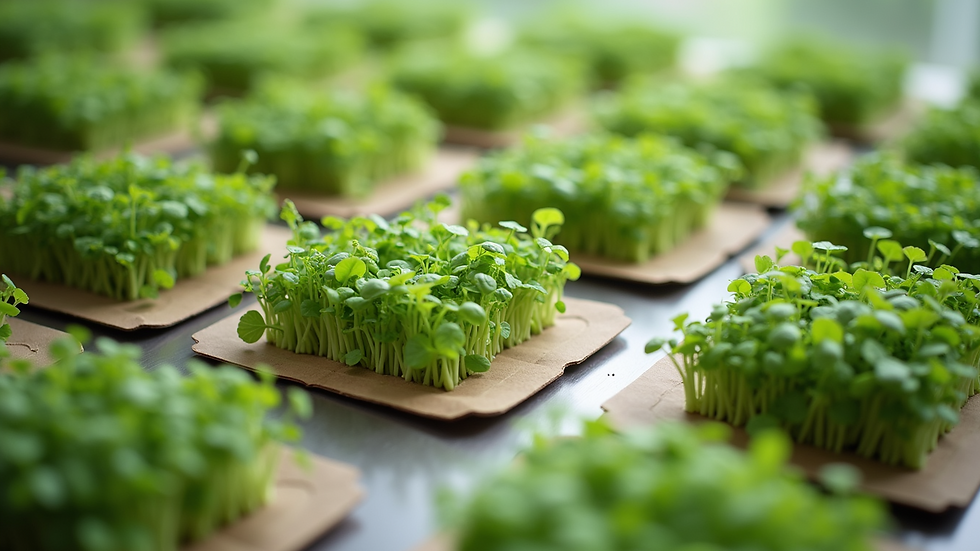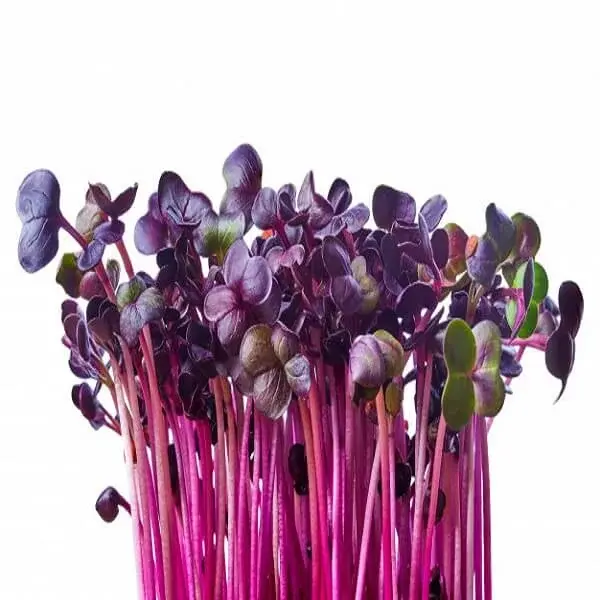How to Grow Microgreens at Home in India
- mikrogrens

- Jul 31
- 4 min read
Microgreens are tiny versions of vegetables and herbs that pack a lot of flavor and nutrients. In India, where space can be limited, home microgreens cultivation is a fantastic way to grow your own fresh produce. Not only do microgreens enhance the taste of your dishes, but they also bring a burst of color and nutrition to your meals. This guide will take you through everything you need to know about growing microgreens at home in India, from selecting the right seeds to harvesting your greens.

Home Microgreens Cultivation: The Basics
Growing microgreens requires little space and can be accomplished indoors or outdoors, depending on your preferences and environment. To begin, you need to gather a few materials:
Containers: You can use shallow trays, seedling flats, or even recycled containers like old plastic containers. Ensure they have drainage holes.
Soil: A quality potting mix is essential. Look for a mixture that retains moisture but allows for good drainage.
Seeds: Choose seeds specifically intended for microgreens. Popular options include radish, broccoli, mustard, and basil.
Water: A spray bottle or a watering can for gentle watering.
Light: Microgreens need plenty of light. A sunny window or grow lights can provide the necessary illumination.
Choosing the Right Seeds
Selecting the right seeds is crucial for successful microgreens cultivation. Many seeds can be used, but some of the best options for beginners include:
Radish Seeds: They germinate quickly, providing fast crops in just 5 to 10 days.
Basil Seeds: Known for their aromatic flavor, they thrive in warm conditions and should be watered carefully.
Cabbage Family Seeds: Such as broccoli and kale, provide excellent nutrition and flavor.
When starting with seeds, look for organic options to ensure you grow healthy and chemical-free greens.

Is Growing Your Own Microgreens Worth It?
Absolutely! Microgreens are not just versatile but also packed with nutrients. According to research, microgreens can have up to 40 times more nutrients than their mature counterparts. This not only enhances the nutritional value of your meals but also allows you to experiment with various flavors and textures in your cooking.
Moreover, cultivating microgreens can be therapeutic. Tending to plants often reduces stress and makes you feel connected to nature. It’s an investment in health and well-being. Plus, having fresh greens on hand can save you money in the long run!
Preparing the Soil and Containers
Once you have your containers and seeds ready, it's time to prepare the soil. Fill your container with the potting mix, leaving about half an inch of space from the top. Level the soil and lightly press down to remove air pockets. It’s essential to ensure the soil is moist but not soggy.
After preparing the soil, sprinkle the seeds evenly across the surface. Follow the instructions on the seed packet for specific spacing and coverage. For optimal results, lightly cover the seeds with a thin layer of soil.

Watering and Caring for Microgreens
Watering your microgreens properly is critical. Use a spray bottle to give them a mist of water. Avoid over-watering, as this can lead to mold growth. The soil should be kept moist but not wet. Check daily and water as needed to maintain moisture.
Microgreens need adequate light to grow. If you’re growing them indoors, place them near a sunny window that gets at least 4-6 hours of sunlight daily. If natural light is limited, consider using grow lights. Position the lights close to the seedlings, as they will stretch towards the light, which could lead to leggy and weak plants.
Harvesting Your Microgreens
In about 7 to 14 days, your microgreens will be ready for harvest. Harvest when the seedlings have grown their first true leaves (known as cotyledons). Use scissors to cut just above the soil line, allowing the roots to remain intact in the soil.
It's best to harvest in the morning, ensuring they are fresh for your meals. Microgreens will stay fresh in the refrigerator for about a week. Seal them in a container to maintain their crispness and flavor.
Incorporating Microgreens into Your Meals
Now that you’ve grown your microgreens, it's time to enjoy them! Microgreens can be used in various dishes:
Salads: Add a handful to your regular salads for a flavor boost.
Sandwiches: Use them as a crunchy layer in sandwiches and wraps.
Smoothies: Toss in a handful for added nutrition.
Garnishes: Use microgreens to elevate dishes like soups, stews, and entrees.
Their vibrant colors and flavors make them an attractive addition to any plate, enhancing both presentation and taste.
Tips for Successful Microgreens Cultivation
Here are some practical tips to ensure a successful microgreens-growing experience:
Experiment with Varieties: Don't be afraid to try different types of seeds. See what grows best in your environment.
Monitor Temperature: Most microgreens thrive in temperatures between 20-24°C. Avoid drastic temperature changes.
Keep It Clean: Be vigilant about cleaning your containers and soil to deter pests and diseases.
Practice Patience: Growing microgreens is a quick process, but don’t rush. Allow them to reach their full potential before harvesting.
The Sustainable Choice
Growing microgreens at home is not just beneficial for your health; it's also great for the planet. By growing your own greens, you can reduce your carbon footprint. You'll buy fewer packaged products and rely less on store-bought greens that come from distant farms.
Additionally, many microgreens can thrive in small spaces, making them a perfect choice for urban dwellers in India. You can grow them on balconies, windowsills, or even on kitchen counters.
Growing microgreens at home is an engaging way to enhance your culinary skills while also prioritizing health and sustainability. With minimal space and effort, you can cultivate a steady supply of fresh, nutritious greens year-round. Whether you’re a seasoned cook or a kitchen novice, home microgreens cultivation offers a rewarding experience that leads to flavorful and healthful meals. Start your microgreens journey today, and enjoy the benefits they bring to your kitchen and lifestyle!



















Comments